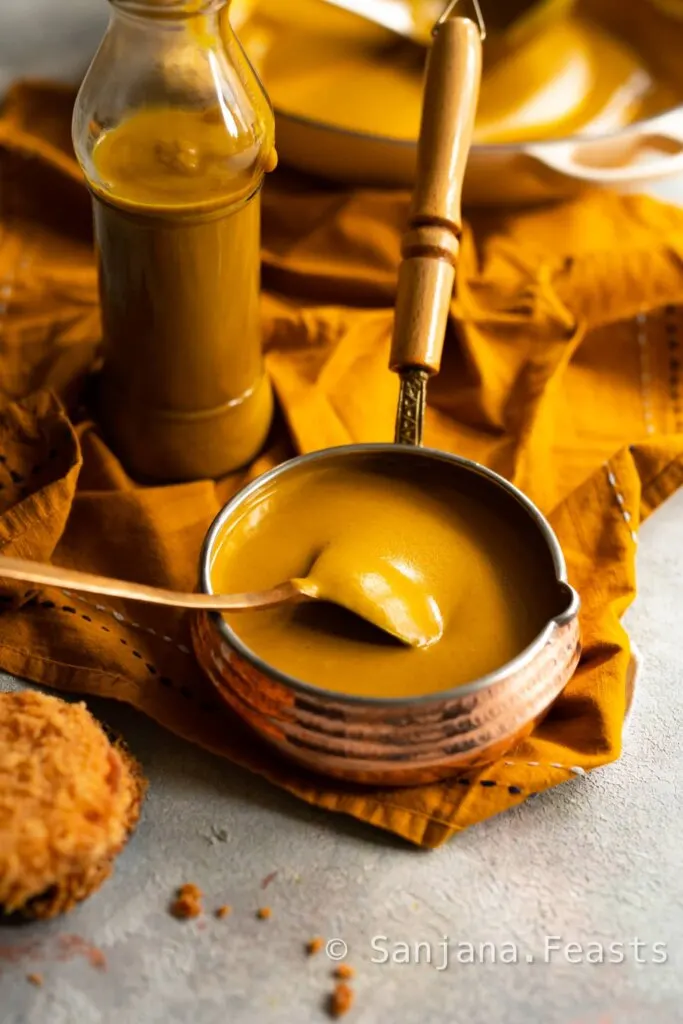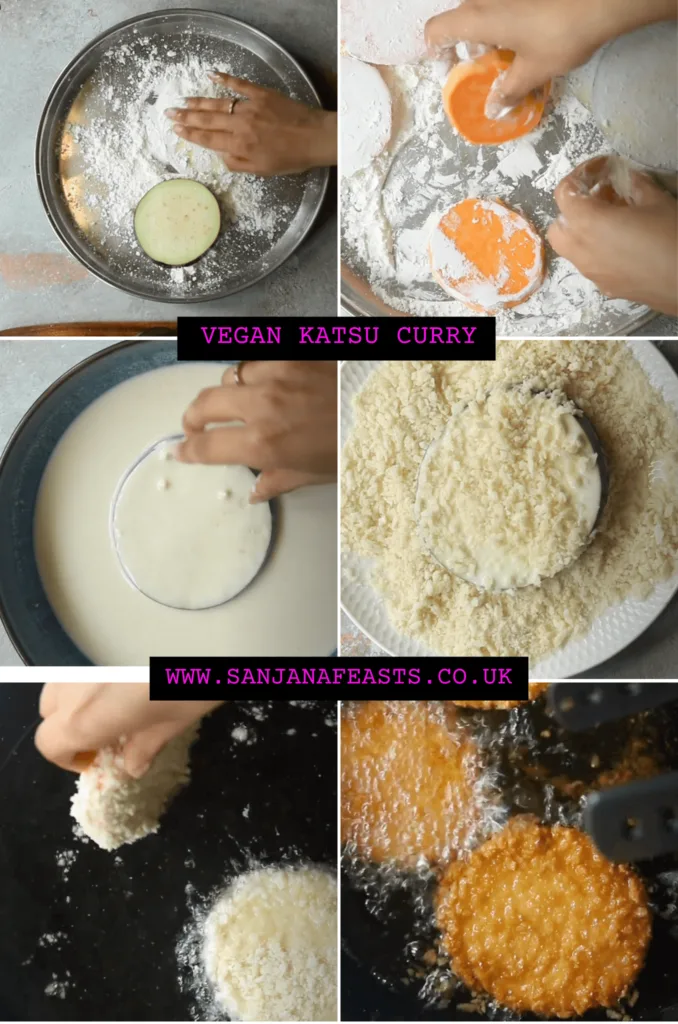I now double the recipe each time so there are enough leftovers for the next day. This vegan katsu curry recipe (yasai katsu curry) combines aubergine and sweet potato coated in panko breadcrumbs and creamy coconut curry sauce.
My vegan Katsu Curry is…
Rich, creamy and crispy Egg, dairy and meat free Powered by six types of vegetables and fruits Great for kids Perfect for batch cooking
It’s a recipe that’ll give you the feeling of having eaten out, without actually having to eat out… or order in. I’m all about saving where possible. Indeed, Bodhi Feasts is a Wagamama connoisseur who will jump at the opportunity to grace the long benches of the pan-Asian restaurant. He learnt to say ‘Yasai Yaki Soba’ before he could even peep over the bustling tables.
What is Katsu Curry?
Katsu curry is a Japanese dish of deep-fried cutlets in a curry sauce. It is typically prepared with pork, but many versions are now popular, from chicken katsu curry, to tofu katsu curry. It is believed to have originated in the late 19th century, when Japanese chefs began to experiment with Western-style ingredients, such as Britain’s most famous invention (and export), curry powder. At the time, it was not unusual for British-style curries to use fruit as a sweetening element. Taste buds were not accustomed to very spicy dishes. After colonising vast parts of the world, including the Indian subcontinent, the British invented curry powder to make cooking with spices (and cooking Indian ‘kari’) accessible. This simplified method of preparing curry was introduced to Japan by British military personnel during the Meji period (1868–1912). It later became known as karē. The word ‘katsu’ is said to come from the English word ‘cutlet’. The dish quickly became popular, and is now a staple of Japanese comfort cuisine.
What to serve with Katsu Curry
Katsu curry is typically served with short-grain white rice, and can be garnished with a variety of toppings. Shredded cabbage, pickled ginger and onions are all refreshing sides. This is a popular dish for both lunch and dinner, and can be found in many restaurants and homes in Japan and beyond.
How to make Katsu Curry Sauce
The curry sauce for katsu curry is typically made with a base of vegetables, fruits, spices and coconut milk. It should be smooth and glossy and can range in colour from golden brown to a deep caramel. The flavour of katsu curry sauce is a complex one. Every recipe is different but ingredients can include onion, carrot, apple and even banana! Coconut milk offers balance and creaminess against all the warm spices. The spice in katsu curry sauce comes from the spices that are used in the curry roux. The most common spices used in katsu curry sauce are turmeric, cumin, coriander and star anise. Ultimately, the flavour of katsu curry is a matter of personal preference. Some people prefer a sweeter sauce, while others prefer a spicier sauce. There is no right or wrong answer, it all comes down to what you like. A vast majority of recipes and restaurants opt for using block-form curry pastes which are readymade tablets of curry powder roux. They look a little like stock cubes but cook to create a rich and thick curry sauce.
Japanese curry block
S&B Golden Curry (affiliate link) block is globally one of the most popular choices. The cult status of S&B Golden Curry can be attributed to a number of factors. It’s well-balanced, with a great blend of sweetness, spice, and umami. It’s also pretty handy to keep in the cupboard for rustling up curry whenever you feel like it. Other popular curry roux blocks include Yutaka and House Foods. While I’m a fan of a good shortcut now and again, there really is nothing like making your own Japanese curry. This way, I’m able to squeeze a whopping six different fruits and veggies into the dish, which is incredible for a dish we eat regularly. If I made this with the time-saving curry block, I’d only have two sources of veg; the aubergine and sweet potatoes in the cutlets. The recipe below will detail all the information you need for making Japanese katsu curry sauce from scratch but for the most part, the point is to promote a slow caramelisation of the vegetables and aromatics. This will develop the sweet, aromatic, umami flavours of the curry which are a core building block of flavour. Remember to caramelise the aromatics well to develop the deep, rich aromas that Japanese karē is so well known for.
Tips and tricks for making Katsu Curry
Here are a few tips and tricks for making katsu curry at home
Use panko breadcrumbs. The devil is in the detail. Choose these coarse breadcrumbs over fine for the crispiest coating. The quality of the ingredients you use will make a big difference in the taste of your katsu curry. Don’t overcrowd the pan when frying the cutlets. If you overcrowd the pan, the temperature of the oil will drop and the ingredients will not cook evenly. Use a good curry sauce. There are many different curry sauces available, so take some time to find one that you like. Don’t be afraid to experiment. There are many different ways to make katsu curry. Feel free to experiment with different ingredients and flavours.
What are panko breadcrumbs?
Panko breadcrumbs are a type of breadcrumb that is made from Japanese bread. They are made from crustless white bread that is steamed, then dried and shredded into flakes. They’re larger and flakier than regular breadcrumbs, and they have a more airy texture. This makes them ideal for breading foods that you want to fry, as they will create a light and crispy coating. Panko breadcrumbs are a popular ingredient in Japanese cuisine, and they are also used in many other cuisines around the world.
Where to buy panko breadcrumbs
Panko breadcrumbs can be found in most grocery stores. They are typically sold in bags or boxes, and they can be stored in the pantry for up to six months.
Can I make my own panko breadcrumbs?
If you can’t buy panko in your local area, the next best thing is to make your own. Simply grate a loaf of stale bread on the coarse side of a cheese grater.
Can I substitute aubergine and sweet potatoes in this recipe?
Here are some more suggestions for the breaded cutlet element:
Tofu Katsu Curry Pumpkin Katsu Curry Seitan Katsu Curry Cauliflower Katsu Curry Jackfruit Katsu Curry
You may also simply add your favourite vegetables and proteins to the curry and serve with rice. No cutlets. I usually make extra sauce so I can do this later in the week.
Ingredients for Katsu Curry
Aubergine: I use the large, European variety. You may also use long, thin Asian aubergines for this recipe. No need to salt or peel the aubergines in advance.Sweet potato: We will use sweet potatoes twice in this recipe. Once for the breaded cutlets, and again in the sauce. Blending sweet potatoes into the sauce adds sweetness, a beautiful colour and nutrients.Panko breadcrumbs: I buy mine from my local East Asian supermarket. Use your favourite brand or make your own (see above).Cornflour: Also known as cornstarch. This will help the breadcrumbs stick to the sweet potatoes and aubergines. It is also in the batter.Plain flour: All-purpose flour. For the batter and curry roux.
Katsu Curry Sauce
Onion: A regular brown onion is fine here. I use one large.Carrot: Cut into rounds. Packs extra veggies into the sauce and sweetness.Apple: A sour variety like Granny Smith is ideal, but in all honesty, any will do. The apple give the sauce a sharpness to balance the sweet and spicy flavours. No need to peel.Banana: Another sweet element. Most people wouldn’t believe there’s banana in this curry sauce. It adds a remarkable flavour dimension to Katsu Curry. Don’t skip it!Light soy sauce: A salty, umami flavour. If you prefer a darker, richer colour, use dark soy sauce. You may need to add more salt if using dark soy sauce as it typically contains less sodium than light soy sauce.Madras curry powder: Use your favourite shop-bought blend, or make your own.Chinese 5-spice: Again use shop bought or homemade.Garam masala: Try my Homemade Garam Masala recipe, or buy it premade.Coconut milk: I use full fat coconut milk for the best emulsification into a smooth and glossy sauce.Mango chutney: My favourite brand is Geeta’s, but use any you like. Don’t skip this ingredient! Other ingredients: Oil, water, salt, garlic, red chillies (or chilli powder), dried bay leaves, cinnamon stick, star anise, turmeric, white pepper, jasmine rice (for serving).
6 Steps for making Katsu Curry
1. Slice the aubergine and sweet potatoes
Cut the vegetables into 5mm-thick rounds. Try not to cut them too thick or they won’t cook through properly.
2. Coat the vegetables in panko breadcrumbs
Dust the veggies in cornflour to help the batter to stick. Then dip briefly in the wet batter (recipe below) and immediately coat with panko breadcrumbs. Do not double coat the veggies. This will make the batter too thick therefore, preventing the vegetables from cooking.
3. Caramelise the vegetables and fruits for the sauce
Brown the chopped vegetables and fruits, along with whole spices. Allow them to caramelise for at least 20 minutes or longer. The longer you cook it, the more flavoursome the curry will be. Anywhere from 20-40 minutes is ideal.
4. Add the flour, dry spices and coconut milk
Be sure to keep everything over a low heat to prevent burning. Toast the flour a little for extra colour. The flour will thicken the sauce. Add coconut milk and stir well. Simmer a while longer if you have time.
5. Blend the curry sauce
Remove the whole spices and blend until smooth, thick and glossy. Adjust the consistency of the sauce with additional water if necessary.
6. Fry the cutlets
For the best golden colour and crunch, deep fry the sweet potato and aubergine cutlets. They’ll need around 5-6 minutes in 160°C/320°F oil to cook through.
Can I air fry the aubergine and sweet potato?
Yes, to air fry aubergine and sweet potato cutlets for katsu curry… Pre-heat the air fryer to 160°C/320°F. Spray the slices generously with oil on both sides. Arrange the slices in the basket of the air fryer. Air fry at 160°C/320°F for 12-15 minutes, or until the breadcrumbs have browned and the sweet potatoes and aubergines have cooked through. Turn halfway through the cooking time and re-spray with oil if you would like the outside to be crispier. Note that the cutlets will not have the same even browning as they would if you were to fry them. Find more alternatives to deep frying in the recipe card notes below.
How to freeze curry sauce
Katsu curry sauce freezes well, as do the breaded cutlets. Place in a freezer-safe container and freeze for up to 3 months. Defrost the sauce at room temperature and heat through before serving. Fry the cutlets from frozen. You can make the cutlets in advance. Fry as per recipe instructions and reheat in an air fryer or oven to crisp up once more before serving.
Is katsu curry good for kids?
This Katsu Curry is a great option for kids. It contains six different types of fruit and veg! To the recipe below, I would recommend a few adjustments. Firstly, you may want to omit the chilli and use a mild curry powder. Secondly, you can also reduce the sodium content by removing the additional salt.
How to make Vegan Katsu Curry | Vegan Katsu Curry with Aubergine and Sweet Potato
If you like this, you’ll love my recipe for Veg Manchurian
More recipes you might like
With love and Vegan Katsu Curry,
To air fry the aubergine and sweet potato cutletsPre-heat the air fryer to 160°C/320°F. Spray the slices generously with oil on both sides. Arrange the slices in the basket of the air fryer. Air fry at 160°C/320°F for 12-15 minutes, or until the breadcrumbs have browned and the sweet potatoes and aubergines have cooked through. Turn halfway through the cooking time and re-spray with oil if you would like the outside to be crispier. Note that the cutlets will not have the same even browning as they would if you were to fry them.To oven bake the aubergine and sweet potato cutletsPre-heat the oven to 180°C/350°F. Spray the slices generously with oil on both sides. Arrange the slices on a baking tray. Bake for 20-25 minutes, or until the breadcrumbs have browned and the sweet potatoes and aubergines have cooked through. Turn halfway through the cooking time and re-spray with oil if you would like the outside to be crispier. Note that the cutlets will not have the same even browning as they would if you were to fry them.To shallow fry the aubergine and sweet potato cutletsHeat around 2cm oil in a frying pan. Carefully place the cutlets in the pan and cook over a medium heat for 10-12 minutes, until golden all over. The colour will be much more golden than air frying or baking but they will take longer to cook through in comparison to deep frying.Katsu curry sauce freezes well, as do the breaded cutlets, for up to 3 months. Fry the cutlets from frozen and ensure the sauce is piping hot before serving.You can make the cutlets in advance. Fry as per recipe instructions and reheat in an air fryer or oven to crisp up once more before serving.
Sanjana x Share this recipe

































































